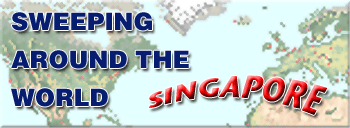 |
Singapore: Moving Toward Environmental Sustainability
by Ranger Kidwell-Ross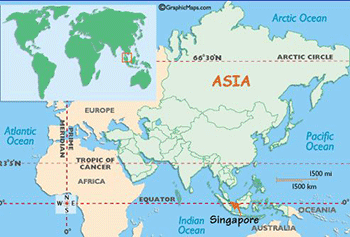
Author's Note: When I interviewed the people in charge of pavement cleaning in the City of Hong Kong several years ago, I found the sweeping program there had an excellent level of organization and a high frequency of sweeps. The management team members were justifiably proud of their pavement-cleaning program.
However, when I asked them if they thought any other Asian cities exceeded the level of pavement cleanliness Hong Kong attained, I was surprised by the answer: "Perhaps Singapore," I was told with the caveat "but at least part of the reason is that country's very strong laws against the throwing of debris." Ever since, I've wanted to see for myself.
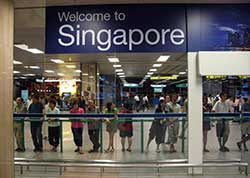
In February of 2007, I was afforded that opportunity when I traveled to Singapore and met with members of the country's Environmental Health Department. As you'll learn, even though Singapore does have very strong anti-littering laws, they're backed with an outstanding public awareness program and a budgetary recognition of the sweeping frequency and equipment needed to minimize air and water pollution as well as keep the pavement clean. Before getting into the details on Singapore's pavement sweeping program, however, most people will want an overview on how the country has successfully grown into the industrial showpiece it is today.
Singapore is an island that is both a city and a sovereign country. Up until the mid-twentieth century, Singapore had a worldwide reputation as a rough-and-tumble port on the Asian frontier.
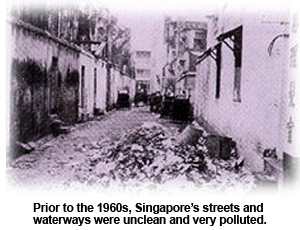
When a British trading post was founded there in 1819, the economic lifeline of the country became the Singapore River. As an English colony, Singapore's story was the typical one of exploitation. Because of its small size and lack of natural resources, when it finally gained full independence in 1965 Singapore faced dire prospects both economically and environmentally.
Located just one degree north of the equator, the warm climate means organic refuse decays quickly, which contributes to the threat of tropical diseases. Yet, as may be seen in the photos from that era, environmental cleanliness on the river and elsewhere apparently didn't ever make it to the top of the government's 'to-do' list. Since virtually all the food vending was done outdoors in what were called 'hawker markets,' which had very poor sanitation, not surprisingly it was health issues that finally mandated changes starting in the late 1960s.
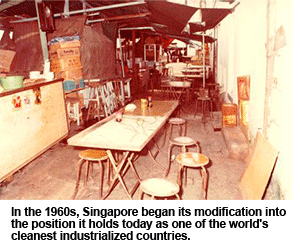
However, the turning point came in 1977 when the government launched a massive cleanup of the river. It took almost 10 years of effort for the once-polluted Singapore River to become clean once again. Today, the formerly run-down areas along the river have also been replaced with sensitively restored heritage buildings reborn as eateries, shops and offices. A total of 125 Hawker Centers have now been established around the country in permanent locations that all have ready access to potable water and up-to-date sanitation.
In the last decade, especially, the country has made spectacular progress. When it comes to keeping its pavement and associated business areas clean, Singapore is today a sparkling example of what can occur with cutting-edge, 21st century environmental management techniques. In addition to being a beautiful, though highly industrialized, place to live, Singapore's citizens enjoy a great standard of living (2003 per capita GDP was S$38,000), an extremely low crime rate and one of the highest per capita home ownership rates in the world.
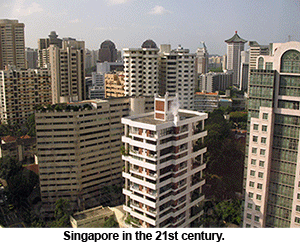
The country's current population is approximately 4.5 million, all of who live in an area of 347 square kilometers (half of the island's 697 sq. km. total is devoted to water catchment). Within the country's boundaries lie 7000 kilometers of roads and another 4500 kilometers of other types of pavement.
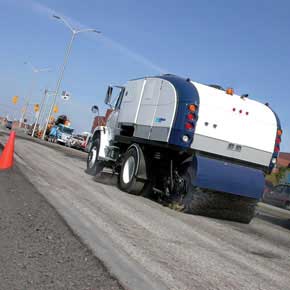 Allianz (formerly Johnston) is the world's largest manufacturer and distributor of street sweepers.
Allianz (formerly Johnston) is the world's largest manufacturer and distributor of street sweepers.
The Allianz model shown, the MS/MT350, is a very rugged mechanical broom machine that incorporates years of engineering expertise across several continents. The chassis-mounted sweeper is available in either single- or twin-engine configuration, and features the Allianz 'ergo' switch for one-button operation for all sweeping functions. With a direct hydraulic drive there are fewer wear parts, and the 4.5 cu. yd. debris hopper and 375 gallon water capacity increase productivity. If you're in the market for a truly rugged broom machine that's easy and cost-effective to operate, click here or on the photo for more information. |
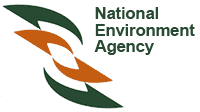
Singapore's National Environment Agency (NEA) oversees all factors that might contribute to food hygiene, spread of disease, and air or water pollution.
Any new industrial proposals must meet stringent NEA standards; an industry deemed too pollutive, toxic or hazardous, or too energy- or water-intensive, is rejected. Once built, the NEA monitors individual polluters as well as ambient air quality. This is done at 11 stations scattered around Singapore, and monitoring is done according to USEPA'a Primary Air Quality Standards and the WHO's Air Quality Guidelines.
The NEA also actively educates polluters on whatever clean alternatives exist, as well as the general public on what can be done on a personal level to lower incidences of pollution. This strategy has gained for Singapore an enviable air quality record of 100% of its days being rated 'good' or 'moderate.' For contrast, this is the same as San Francisco, and better than New York, Atlanta, Boston, Washington DC, and Los Angeles.
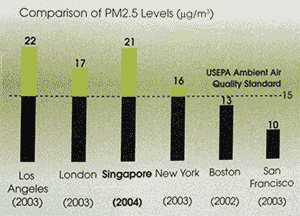
On the downside, even though its PM10 emissions are within international standards, when it comes to smaller, PM2.5 particles Singapore is at about the same poor level as Los Angeles. (The USEPA credits PM2.5 particles with causing 95,000 cases of chronic and acute bronchitis; 10,000 hospital admissions for respiratory and cardiovascular diseases; and hundreds of thousands of aggravated asthma cases in the US each year.)
Innovative early on, in 2001 the country began offering green vehicle rebates to help lower the cost differential between the less pollutive electric and hybrid cars and conventional gasoline-powered cars. In 2004, a rebate package was offered to owners of buses, taxis and other commercial vehicles to encourage their early switch to Euro IV diesel-compliant vehicles, or to CNG-powered ones, prior to implementation of Euro IV emission standard for all new diesel vehicles registered from October of 2006. A 'green vehicle tax incentive' also encourage the use of green vehicles which are less pollutive than conventional petrol and diesel driven vehicles.
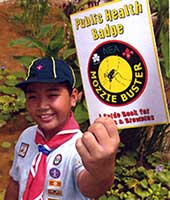
'Vectors' is a term given to animals that carry disease that can infect humans. Examples of vector-borne diseases are dengue fever, malaria, typhus and bubonic plague, all of which can cause immense suffering and loss of life, especially in a tightly-packed urban environment like Singapore's. The country's clean environment programs have kept it malaria-free; however, dengue fever is on the rise due to a particular type of mosquito, and eradication efforts are being increased. A partnership with the Singapore Girl Guides Association and Singapore Scout Associate now educates children on dengue prevention in the home.
Rodents are kept in check by a strong effort to deny the animals a food source. The importance of food cleanup has been stressed through public awareness and, in part, reenforced by the country's extraordinary nationwide pavement-sweeping program. A Public Health Badge has also been developed by NEA to instill good food hygiene habits
Singapore is 100% sewered, which means all urban runoff water is collected and treated. Historically, once treated, effluent water was discharged into the sea. Starting in 2002, the country began using advanced membrane technologies to treat effluent to a potable standard, reclaiming large volumes of used water into an end product called 'NEWater.'
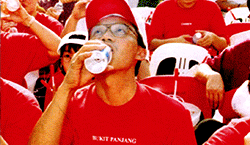
The reclaimed NEWater exceeds WHO requirements and is also cheaper than desalination. Overwhelming public buy-in was shown in 2002 at the country's National Day Parade, when 60,000 people drank from bottles of NEWater that had been distributed to the audience. This public action cleared the way for NEWater to start being mixed with the rainwater in Singapore's reservoirs.
Singapore has also pursued a strong emphasis on finding all unaccounted for water losses, a foretaste of what experts predict all countries will soon need to do in order to safeguard, and minimize the use of, municipal water supplies. Called UFW Ð Unaccounted-For-Water Ð this is the difference between the amount of water produced and the total amount accounted for. In 1989, the figure for UFW was 11%. (Due to high penalties, illegal draw-off of water is rarely a cause.)
Today, the UFW figure has been reduced to 5% through a variety of actions. These include public education; pricing/metering that reflects water's strategic importance and scarcity value; making water-saving devices mandatory, encouraging use of NEWater, industrial water and seawater in commercial/industrial settings; conducting water audits for any customers consuming more than 5000 cu. meters/month; and legislative measures designed to deter wastage and unauthorized water usage.
With limited land in which to site landfills, Singapore's policy is to burn combustible garbage in one of the country's four, government-owned incinerators. That's what currently happens to 91% of all the waste that is not recovered, reused or recycled. Advanced air pollution control equipment is used on these incineration plants, and the incinerators generate 2-3% of Singapore's total electricity. The 9% that won't burn is added to the ash from incineration and landfilled.
From 1970 to 2000 the country's amount of solid waste increased sixfold. However, in 2000 Singapore began pursuing a strategy called 'Toward Zero Landfill.' This effort, aimed at both recycling and waste minimization, has resulted in a decrease since then of almost 4% per year in the total waste stream, and an increase in the overall rate of recycling by 2% per year over the same time period. This program includes, for example, an NEA initiative designed to educate retailers and consumers to use fewer plastic bags than the 2.5 billion now used each year. (By contrast, US consumers use a similar amount about every 144 days.)
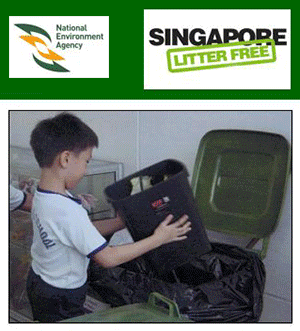
The foundation Singapore has in place for educating all segments of the country about 'garbage accountability' is impressive. The central program is based around what is called the '3P Partnerships Concept: People, Private and Public.'
The 'People' portion includes a large effort encouraging the citizens of Singapore to clean up after themselves, as well as well as to have a zero tolerance of anyone who refuses to do so. One of the country's groundbreaking campaigns calls for 'ownership of your litter.' A practical application of this concept is applied at large public gatherings. Prior to the end of festival-type events, garbage bags are passed out and attendees work together to clean up and bag any litter that's been left on the ground. Before the crowd goes away, the vast majority of litter has been cleaned up.
Children are involved in this concept at an early age, both through example and through education. A wide variety of posters are dispersed extolling the virtue of keeping Singapore clean, and these range from educational to humorous. The message is further reinforced through a variety of grassroots organizations and volunteer groups.
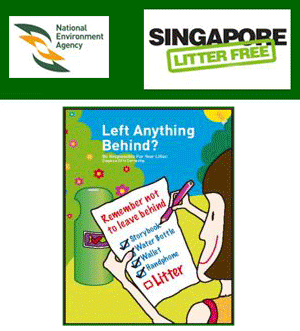 Also important, trash receptacles are available on most all city streets at a maximum distance of 50 meters apart. This makes it easy to dispose of debris correctly, especially since these are, for the most part, kept emptied and sparkling.
Also important, trash receptacles are available on most all city streets at a maximum distance of 50 meters apart. This makes it easy to dispose of debris correctly, especially since these are, for the most part, kept emptied and sparkling.
The second 'P' in the equation stands for 'Private:' These are the service providers who do the work of keeping the city/country clean. This includes the sweeping and garbage collection companies, as well as the pest control companies.
For example, in 2004 Altvater Jakob, the contractor company involved in street cleaning and waste collection in one of Singapore's sections, organized in 143 schools in its market area the 'Students Must Always Recycle Trash' (SMART) program. The schools earn points for the amount of recyclables collected and can exchange these points for school equipment like printers and scanners. The NEA is currently working with the other public waste collectors to introduce similar programs.
The final 'P' belongs to 'Public:' In the 1990s, Environmental Education Advisors were appointed in each school in the country. An annual 'Clean and Green Week' was launched as a countrywide education effort encouraging individuals to take responsibility for the environment, as well as encouraging green groups, schools and companies to take a leadership role. At the same time, Singapore's National Council on the Environment was begun.
The 'Keep Singapore Clean and Pollution-Free' message is promoted by the Ministries of Education and of Manpower, as well as by a government-sponsored group called The People's Association. This latter is a unique concept that offers chapters in each sub-community of the city. It's an organized way to get those living in neighborhoods together both socially and to further the specific needs of the area in which they live.
As an example, interested individuals are organized to visit neighbors to make sure people don't unwittingly have mosquito breeding areas in their homes; these are often the trays under potted plants. Since the dengue fever borne by mosquitoes is a serious concern, removal of any such standing water is a high priority. This type of 'neighbors meeting with and helping other neighbors' organization sounded like something that would be of benefit to any large city in the world.
A national recycling program was rolled out in 2001, with plastic, glass, paper, metal and old clothing collected door-to-door twice per month from homes. Recycling bins, some of which are sponsored by the business community, have been placed throughout the island at high pedestrian traffic locations. The NEA also spreads the recycling message over the radio, on buses, taxis and trains, as well as at various events.
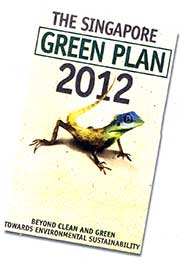
Singapore's environmental roadmap to the future is called 'The Singapore Green Plan 2012,' which further articulates the country's commitment to gaining long-term environmental sustainability. The document seeks to generate a sense of ownership, and a desire to participate, by all aspects of Singapore's citizen, government and business interests.
The overriding national belief is that, by working together, win-win solutions can be found to emerging environmental challenges. Further, there is confidence that competitiveness, convenience and environmental sustainability don't have to be accomplished at anyone's expense.
This story was one written during our editor's trip to Singapore and Thailand in 2007 to investigate how sweeping was done in those countries. If you have questions or comments, please let us know.
 |
© 2005 - 2021 World Sweeper
|
Countries Contents
|